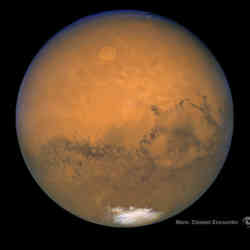
Hubble Space Telescope view of Mars at its closest point 2 years ago. Image credit: Hubble. Click to enlarge.
There’s a rumor going around. You might have heard it at a 4th of July BBQ or family get-together. More likely you’ve read it on the Internet. It goes like this:
“The Red Planet is about to be spectacular.”
“Earth is catching up with Mars [for] the closest approach between the two planets in recorded history.”
“On August 27th ? Mars will look as large as the full moon.”
And finally, “NO ONE ALIVE TODAY WILL EVER SEE THIS AGAIN.”
Those are snippets from a widely-circulated email. Only the first sentence is true. The Red Planet is about to be spectacular. The rest is a hoax.
Here are the facts: Earth and Mars are converging for a close encounter this year on October 30th at 0319 Universal Time. Distance: 69 million kilometers. To the unaided eye, Mars will look like a bright red star, a pinprick of light, certainly not as wide as the full Moon.
Disappointed? Don’t be. If Mars did come close enough to rival the Moon, its gravity would alter Earth’s orbit and raise terrible tides.
Sixty-nine million km is good. At that distance, Mars shines brighter than anything else in the sky except the Sun, the Moon and Venus. The visual magnitude of Mars on Oct. 30, 2005, will be -2.3. Even inattentive sky watchers will notice it, rising at sundown and soaring overhead at midnight.
You might remember another encounter with Mars, about two years ago, on August 27, 2003. That was the closest in recorded history, by a whisker, and millions of people watched as the distance between Mars and Earth shrunk to 56 million km. This October’s encounter, at 69 million km, is similar. To casual observers, Mars will seem about as bright and beautiful in 2005 as it was in 2003.
Although closest approach is still months away, Mars is already conspicuous in the early morning. Before the sun comes up, it’s the brightest object in the eastern sky, really eye-catching. If you have a telescope, even a small one, point it at Mars. You can see the bright icy South Polar Cap and strange dark markings on the planet’s surface.
One day people will walk among those dark markings, exploring and prospecting, possibly mining ice from the polar caps to supply their settlements. It’s a key goal of NASA’s Vision for Space Exploration: to return to the Moon, to visit Mars and to go beyond.
Every day the view improves. Mars is coming–and that’s no hoax.
Original Source: NASA News Release
